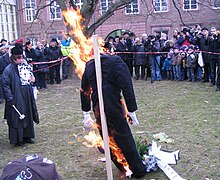Hoppeditz
Hoppeditz , also Hoppediz , a fictional character of the Düsseldorf Carnival , was and is a Düsseldorf arch prankster .
Life



The Hoppeditz, embodied by a renowned carnivalist, is brought to life every year with the beginning of the carnival season on Martin's Day , November 11th , at 11:11 am. From a mustard pot in front of the equestrian statue of Jan Wellem on the Düsseldorf market square in front of the town hall , he gives his funny and biting “opening speech” for the new carnival session, which is answered by the respective mayor from the town hall balcony.
On Ash Wednesday , Hoppeditz is cremated as a doll amid great wailing and lamentation in the garden of the Düsseldorf City Museum and symbolically carried to its grave. As a token of their mourning, the revelers wear black clothes. Traditionally, many people from Düsseldorf say goodbye to Lent with a funeral feast ( fish meal ) .
In 1841 his own monument was erected at today's Carlsplatz (formerly “Hoppedizplatz”) in Düsseldorf by such renowned artists as Andreas Achenbach , Wilhelm Camphausen and Emanuel Leutze . The monument stood until 1860.
Since 2008 there is again a Hoppeditz monument, designed by the artist Bert Gerresheim , this time behind the house of the carnival , which houses both the office of the Düsseldorf Carnival Committee and the Düsseldorf Carnival Museum.
Origin of name
There are different theories about the origin of the name Hoppeditz . One of these leads the name back to the name Hippedotz . The individual components of the name stand for goat (Hipp) and marble (Dotz) . Following a different approach, the word hoppe in Rhenish stands for hopping and the word Ditz for toddler or child, so the Hoppeditz can be translated as hopping child . On 11.11. refers to another explanation. Accordingly, St. Martin's Day was similar to the night of Lent before Easter Lent, the last opportunity to celebrate before the Advent fast . When collecting sweet pastries and firewood from the doors, a little boy was carried astride his shoulders as a Martinsreiter. Such moves through the place were connected with all kinds of jokes.
The other Hoppeditze in the Rhineland
Hoppeditz from Düsseldorf has a number of twin brothers who live out their fun (carnival-like) character in many villages and towns. Twin sisters have also appeared recently.
Trivia
In the 1970s the children's book "Der kleine Hoppediz" and its sequel "Hoppediz und Quirlewitt" by Martha Schlinkert appeared in cursive . In this one, Hoppediz and his dog Quirlewitt are two figures made of cork, made in handicraft lessons. They take their “builder” with them to the star Antares . Apart from the name, this Hoppediz has nothing to do with the above.
Additional information
See also
- Düsseldorf Carnival
- Carnival, Mardi Gras and Mardi Gras
- Nubbel burn
- Martha Schlinkert , author of the story The Little Hoppediz
literature
- Prof. von Worringen: "The song of the foolish Mr. Hoppeditz" , 1841 (cf. the text in the song booklet: AVDK 1844, pp. 51–54, No. 32. The song was based on the melody "Prince Eugene the noble knight" sung.)
- Christina Frohn: "A great striving becomes praiseworthy if it is short and meaningful" , Dissertation Bonn 1999, electronic resource ( PDF )
- Christina Frohn: "The organized fool - Carnival in Cologne, Düsseldorf and Aachen 1823-1914" , Jonas Verlag Marburg 2000, ISBN 3-89445-269-2
